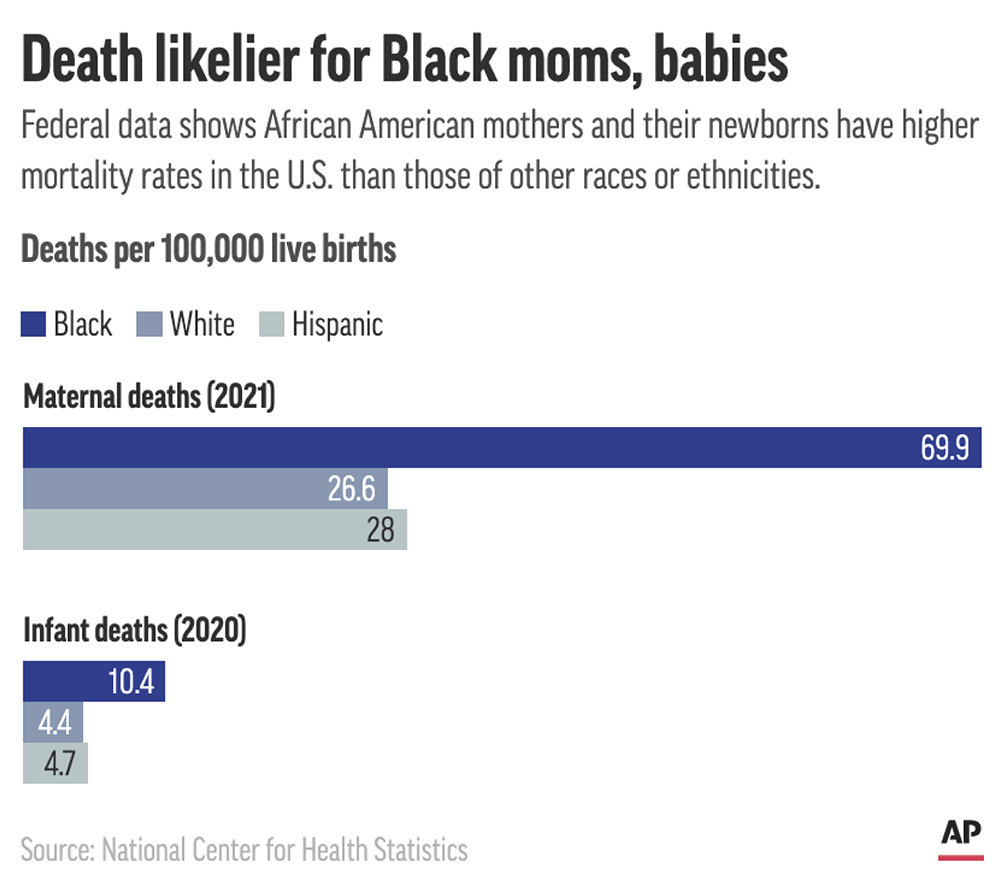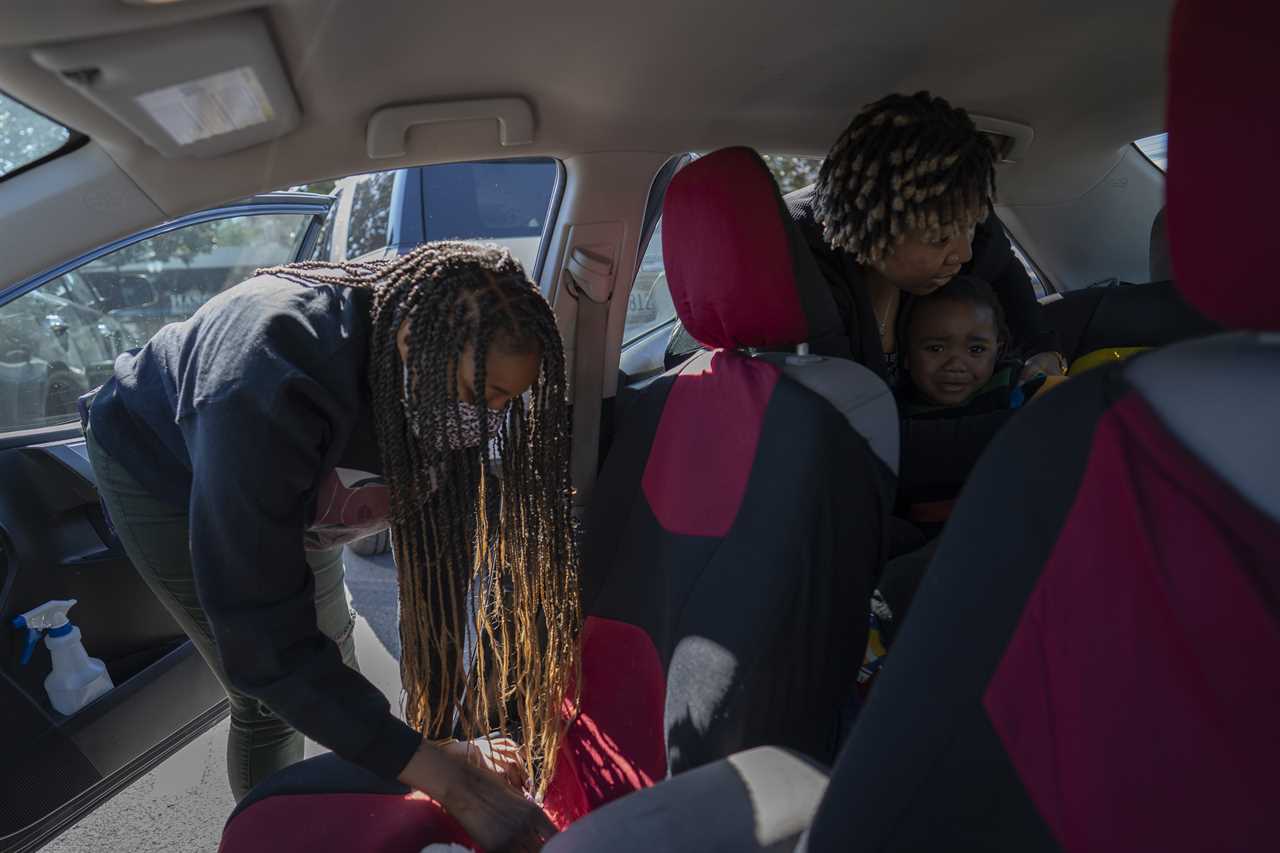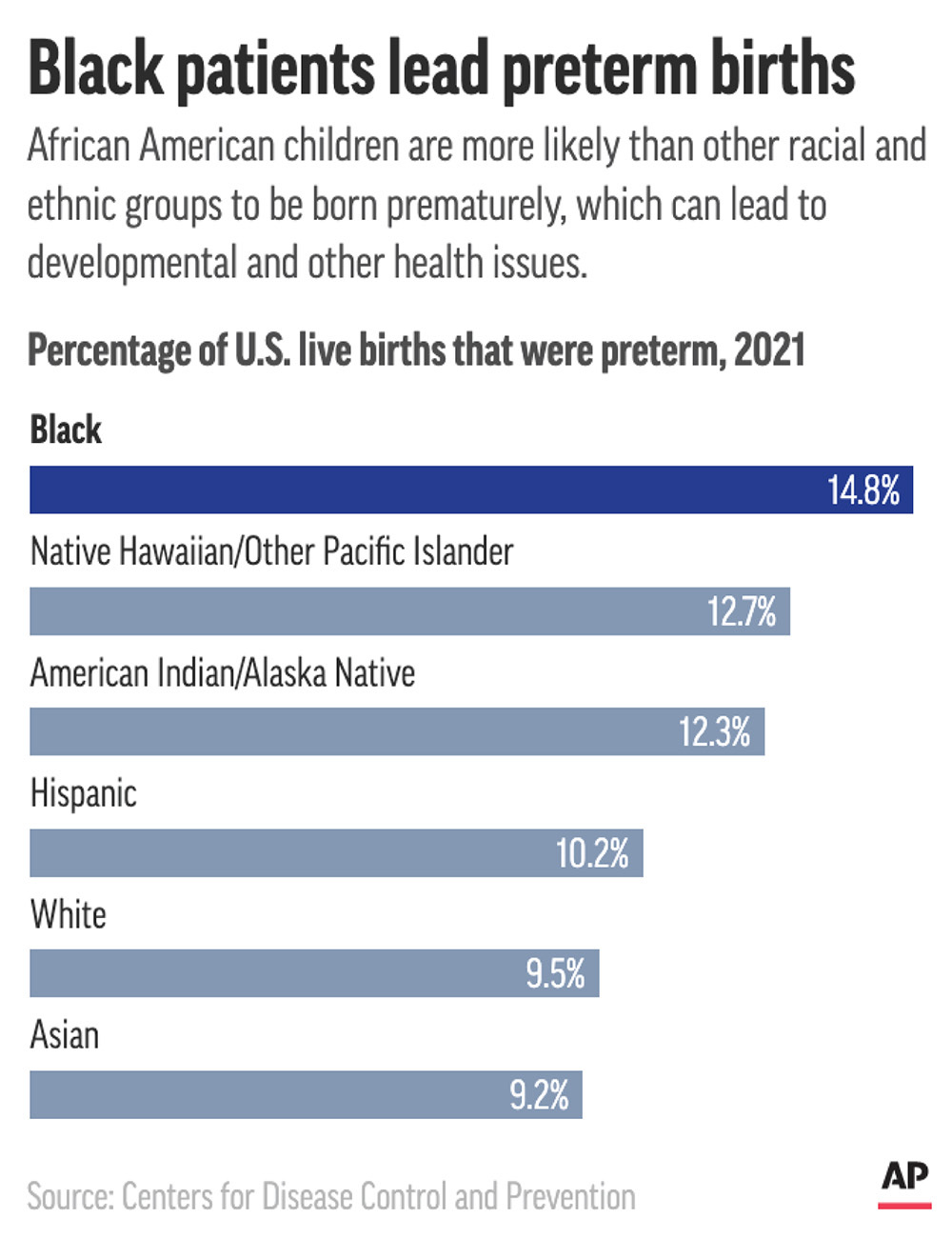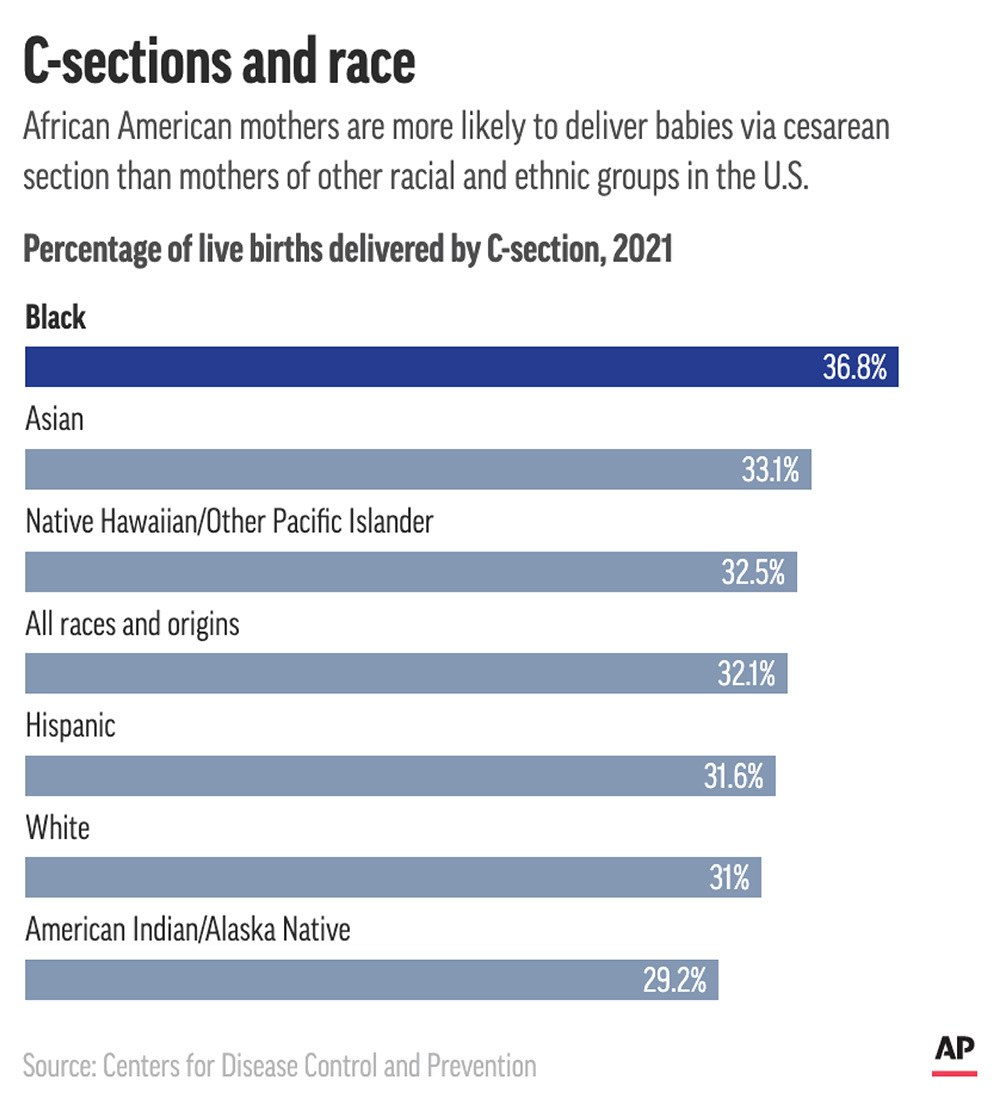---------------------------------------
BIRMINGHAM — Angelica Lyons knew it was dangerous for Black women to give birth in America.
As a public health instructor, she taught college students about racial health disparities, including the fact that Black women in the U.S. are nearly three times more likely to die during pregnancy or delivery than any other race. Her home state of Alabama has the third-highest maternal mortality rate in the nation.
Then, in 2019, it nearly happened to her.
What should have been a joyous first pregnancy quickly turned into a nightmare when she began to suffer debilitating stomach pain.
[time-brightcove not-tgx=”true”]
Her pleas for help were shrugged off, she said, and she was repeatedly sent home from the hospital. Doctors and nurses told her she was suffering from normal contractions, she said, even as her abdominal pain worsened and she began to vomit bile. Angelica said she wasn’t taken seriously until a searing pain rocketed throughout her body and her baby’s heart rate plummeted.
Rushed into the operating room for an emergency cesarean section, months before her due date, she nearly died of an undiagnosed case of sepsis.
Even more disheartening: Angelica worked at the University of Alabama at Birmingham, the university affiliated with the hospital that treated her.
Her experience is a reflection of the medical racism, bias and inattentive care that Black Americans endure. Black women have the highest maternal mortality rate in the United States — 69.9 per 100,000 live births for 2021, almost three times the rate for white women, according to the Centers for Disease Control and Prevention.
Read More: Black Women Are Dying From a Lack of Access to Reproductive Health Services
Black babies are more likely to die, and also far more likely to be born prematurely, setting the stage for health issues that could follow them through their lives.
“Race plays a huge part, especially in the South, in terms of how you’re treated,” Angelica said, and the effects are catastrophic. “People are dying.”
To be Black anywhere in America is to experience higher rates of chronic ailments like asthma, diabetes, high blood pressure, Alzheimer’s and, most recently, COVID-19. Black Americans have less access to adequate medical care; their life expectancy is shorter.
From birth to death, regardless of wealth or social standing, they are far more likely to get sick and die from common ailments.
Black Americans’ health issues have long been ascribed to genetics or behavior, when in actuality, an array of circumstances linked to racism — among them, restrictions on where people could live and historical lack of access to care — play major roles.
Discrimination and bias in hospital settings have been disastrous.
The nation’s health disparities have had a tragic impact: Over the past two decades, the higher mortality rate among Black Americans resulted in 1.6 million excess deaths compared to white Americans. That higher mortality rate resulted in a cumulative loss of more than 80 million years of life due to people dying young and billions of dollars in health care and lost opportunity.
A yearlong Associated Press project found that the health challenges Black Americans endure often begin before their first breath.
The AP conducted dozens of interviews with doctors, medical professionals, advocates, historians and researchers who detailed how a history of racism that began during the foundational years of America led to the disparities seen today.

Angelica Lyons’ pregnancy troubles began during her first trimester, with nausea and severe acid reflux. She was prescribed medication that helped alleviate her symptoms but it also caused severe constipation.
In the last week of October 2019, while she was giving her students a test, her stomach started to hurt badly.
“I remember talking to a couple of my students and they said, ‘You don’t look good, Ms. Lyons,'” Angelica recalled.
She called the University of Alabama-Birmingham Hospital’s labor and delivery unit to tell them she was having a hard time using the bathroom and her stomach was hurting. A woman who answered the phone told her it was a common pregnancy issue, Angelica said, and that she shouldn’t worry too much.
“She made me feel like my concern wasn’t important, and because this was my first pregnancy, I decided not to go because I wasn’t sure and thought maybe I was overreacting,” Angelica said.
The pain persisted. She went to the hospital a few days later and was admitted.
Read More: Our System Criminalizes Black Pregnancy. As a District Attorney, I Refuse to Prosecute These Cases
She had an enema — a procedure where fluids are used to cleanse or stimulate the emptying of bowels — to alleviate her constipation, but Angelica continued to plead with them that she was in pain.
“They were like, ‘Oh, it’s nothing, it’s just the Braxton Hicks contractions,'” she said. “They just ignored me.”
She was sent home but her stomach continued to ache, so she went back to the hospital a day later. Several tests, including MRIs, couldn’t find the source of the issue.
Angelica was eventually moved to the labor and delivery floor of the hospital so they could monitor her son’s heartbeat, which had dropped slightly. There, they performed another enema that finally helped with the pain. She also was diagnosed with preeclampsia, a dangerous condition that can cause severe pregnancy complications or death.
Then she began to vomit what appeared to be bile.
“I got worse and worse with the pain and I kept telling them, ‘Hey, I’m in pain,’” Angelica said. “They’d say, ‘Oh, you want some Tylenol?’ But it wasn’t helping.”
She struggled to eat dinner that night. When she stood up to go to the bathroom, she felt a sharp pain ricochet throughout her body.
“I started hollering because I had no idea what was going on,” she said. “I told my sister I was in so much pain and to please call the nurse.”
What happened next remains a blur. Angelica recalls the chaos of hospital staff rushing her to labor and delivery, putting up a blue sheet to prepare her for an emergency C-section as her family and ex-husband tried to understand what went wrong.
She later learned that she nearly died.
“I was on life support,” recalled Angelica, 34. “I coded.”
She woke up three days later, unable to talk because of a ventilator in her mouth. She remembers gesturing wildly to her mother, asking where her son, Malik, was.
He was OK. But Angelica felt so much had been taken from her. She never got to experience those first moments of joy of having her newborn placed on her chest. She didn’t even know what her son looked like.
Read More: Flowers and Cards Are Nice. I’d Rather Have Bodily Autonomy
Maternal sepsis is a leading cause of maternal mortality in America. Black women are twice as likely to develop severe maternal sepsis, as compared to their white counterparts. Common symptoms can include fever or pain in the area of infection. Sepsis can develop quickly, so a timely response is crucial.
Sepsis in its early stages can mirror common pregnancy symptoms, so it can be hard to diagnose. Due to a lack of training, some medical providers don’t know what to look for. But slow or missed diagnoses are also the result of bias, structural racism in medicine and inattentive care that leads to patients, particularly Black women, not being heard.
“The way structural racism can play out in this particular disease is not being taken seriously,” said Dr. Laura Riley, chief of obstetrics and gynecology at Weill Cornell Medicine and New York-Presbyterian Hospital. “We know that delay in diagnosis is what leads to these really bad outcomes.”
In the days and weeks that followed, Angelica demanded explanations from the medical staff of what happened. But she felt the answers she received on how it occurred were sparse and confusing.
A spokesperson for the University of Alabama at Birmingham said in a statement to The Associated Press that they couldn’t talk about Angelica’s case because of patient privacy laws. They pointed to a recent internal survey done by its Obstetrics and Gynecology department that showed that most of its patients are satisfied with their care and “are largely feeling respected,” and said the university and hospital “maintain intentional, proactive efforts in addressing health disparities and maternal mortality.”
Angelica’s son, Malik, was born eight weeks early, weighing under 5 pounds. He spent a month in intensive care. He received home visits through the first year of life to monitor his growth.
While he’s now a curious and vivacious 3-year-old who loves to explore the world around him, Angelica recalls those days in the ICU, and she feels guilty because she could not be with him.
“It’s scary to know I could have died, that we could have died,” Lyons said, wiping away tears.

Wong Maye-E—AP PhotoAngelica Lyons secures her 2-year old son Malik into his child car seat while her sister, Ansonia Lyons, prepares to ride with her after their breakfast outing to celebrate their father’s birthday,
For decades, frustrated birth advocates and medical professionals have tried to sound an alarm about the ways medicine has failed Black women. Historians trace that maltreatment to racist medical practices that Black people endured amid and after slavery.
To fully understand maternal mortality and infant mortality crises for Black women and babies, the nation must first reckon with the dark history of how gynecology began, said Deirdre Cooper Owens, a historian and author.
“The history of this particular medical branch … it begins on a slave farm in Alabama,” Owens said. “The advancement of obstetrics and gynecology had such an intimate relationship with slavery, and was literally built on the wounds of Black women.”
Reproductive surgeries that were experimental at the time, like cesarean sections, were commonly performed on enslaved Black women.
Physicians like the once-heralded J. Marion Sims, an Alabama doctor many call the “father of gynecology,” performed torturous surgical experiments on enslaved Black women in the 1840s without anesthesia.
And well after the abolition of slavery, hospitals performed unnecessary hysterectomies on Black women, and eugenics programs sterilized them.
Read More: I Was Pregnant and in Crisis. All the Doctors and Nurses Saw Was an Incompetent Black Woman
Health care segregation also played a major role in the racial health gap still experienced today.
Until Congress passed the Civil Rights Act of 1964, Black families were mostly barred from well-funded white hospitals and often received limited, poor or inhumane medical treatment. Black-led clinics and doctors worked to fill in the gaps, but even after the new protections, hospitals once reserved for Black families remained under-resourced, and Black women didn’t get the same support regularly available for white women.
That history of abuse and neglect led to deep-rooted distrust of health care institutions among communities of color.
“We have to recognize that it’s not about just some racist people or a few bad actors,” said Rana A. Hogarth, an associate professor of History at the University of Illinois, Urbana-Champaign. “People need to stop thinking about things like slavery and racism as just these features that happened that are part of the contours of history and maybe think of them more as foundational and institutions that have been with us every step of the way.”
Some health care providers still hold false beliefs about biological differences between Black and white people, such as Black people having “less sensitive nerve endings, thicker skin, and stronger bones.” Those beliefs have caused medical providers today to rate Black patients’ pain lower, and recommend less relief.
The differences exist regardless of education or income level. Black women who have a college education or higher have a pregnancy-related mortality rate that is more than five times higher than that of white women. Notably, the pregnancy-related mortality rate for Black women with a college education is 1.6. times higher than that of white women with less than a high school degree.
In Angelica Lyons’ home state of Alabama, about 40 mothers die within one year after delivery. The toll on Black mothers is disproportionate.

The state’s infant mortality rate for 2021 was 7.6 deaths per 1,000 live births. The disparities between Black and white babies is stark: The infant mortality rate in 2021 for white mothers was 5.8, while the infant mortality rate for Black mothers was 12.1, an increase from 10.9 from the prior year.
Black babies account for just 29% of births in Alabama, yet nearly 47% of infant deaths.
A 2020 report by the Alabama Maternal Mortality Review Committee found that more than 55% of 80 pregnancy-related deaths that they reviewed in 2016 and 2017 could have been prevented.
Alabama launched its Maternal Mortality Review Committee in 2018 to investigate maternal deaths. But Dr. Scott Harris, Alabama’s Department of Public Health State Health Officer, said work remains to collect a fuller picture of why the disparities exist.
“We certainly know that from national numbers as well that Black women have worse maternal outcomes at every income level, which is pretty startling,” said Dr. Harris. “Age matters and just overall ZIP code matters. Unfortunately, where people live, where these children are born, is strongly associated with infant mortality. I think we’ll see something similar for maternal outcomes.”
Read More: Democratic States Are Stockpiling Abortion Pills to Preserve Access
And concerns about access and barriers to care remain.
In Alabama, 37% of counties are maternity care deserts — more than 240,000 women live in counties with no or little care. About 39% of counties don’t have a single obstetric provider.
Alabama is not alone in this. More than 2.2 million American women of childbearing age live in maternity care deserts, and another 4.8 million such women reside in counties with limited access to maternity care.
Angelica Lyons said she wanted to seek maternal care at another hospital but the University of Alabama was the only one near her home equipped to handle her high-risk pregnancy, which included high blood pressure near the beginning.
Dr. Harris acknowledged the lack of access to care is a barrier for Black women who live in the state’s rural areas. Much of the state’s public health efforts are targeted along the rural Black Belt, which gets its name from the rich soil but it was also a region where many plantations were clustered.
Centuries later, the Black Belt continues to be a high-poverty region with a large Black population. More than half of the nation’s Black population lives in the South.
“We’ve talked a lot about structural racism and the impact of that on African American women and how it has no place in society,” Harris said. “I think we have to publicly call it what it is.”
Angelica Lyons’ traumatic birth experience was not the only one in her family. After two miscarriages, her younger sister, Ansonia, became pregnant in 2020, and it was difficult.
Doctors told her she was suffering from regular morning sickness, though she was vomiting blood.
She was eventually diagnosed with an excessive vomiting disorder, hyperemesis gravidarum, and was extremely dehydrated. Ansonia spent months in and out of the same hospital where her sister had been treated.
“They said, ‘Welcome to the pregnancy, sweetheart. This is what pregnancy is,’” Ansonia, 30, recalled. “I told her, ‘No, this is not normal for me to be throwing up 10 to 20 times a day.’ My own primary care wasn’t listening to me.”
Ansonia said throughout her pregnancy she encountered hospital staff that made stereotypical jokes, calling her child’s father her “baby daddy,” a trope often lobbed at Black parents.
“She said, ‘So, your baby daddy, where does he work?’” Ansonia recalled. “I said, ‘I don’t know what a baby daddy is but the father of my child is at work.’ She asked where he worked and I told her he had two businesses and she acted like she was surprised.”
Ansonia said staff assumed she didn’t have any health insurance, when she had insurance through her employer.
Ansonia has Type 2 diabetes and had issues with her blood pressure and heart throughout the pregnancy. She started to see a cardiologist and by the time she was 21 weeks pregnant, she was diagnosed with congestive heart failure. She was placed on a medley of medications, and her doctors decided to deliver the baby early via C-section.
Ansonia was scared, given everything she witnessed her sister go through nearly two years prior.
“There were several times I told my boyfriend that I thought that I was going to die,” she said.
The C-section went well. Ansonia’s son, Adrien, was due in July 2021 but he was born at the end of May.
He spent his first five days in the intensive care unit, then was hospitalized for another two weeks for some early breathing problems.
Cesarean delivery rates are higher for Black women than white women, 36.8% and 31%, respectively, in 2021.

Problems continued for Ansonia after the delivery. She ended up needing a blood transfusion and was unable to see her son for his first few days of life.
A few months postpartum, she was still vomiting and having fainting spells that led to her being admitted to the hospital off and on. Her arms suffered from bruising from needles used to treat her throughout the pregnancy. She had always been slow to heal from any bruising, a common problem for diabetics.
Yet a doctor who had been involved throughout her entire pregnancy questioned why she had bruises on her arms and asked if she “smoked weed” or took any other recreational drugs. The hospital declined to comment, citing patient privacy laws.
“I said, ‘This is from me being stuck so many times and having to be in the hospital.’ I told him I don’t do any drugs,” she said.
He still sent her blood work off to be tested. The tests came back negative.
“That just made me not trust them, it made me not want to go back,” she said.
There are indications that the sufferings of Black mothers and their babies are being recognized, however late.
In 2019, U.S. Rep. Lauren Underwood, an Illinois Democrat, and Rep. Alma Adams, a North Carolina Democrat, launched the Black Maternal Health Caucus. It is now one of the largest bipartisan congressional caucuses. The caucus introduced the Black Maternal Health Momnibus Act in 2019 and again in 2021, proposing sweeping changes that would increase funding and strengthen oversight. Key parts of the legislation have been adopted but the bill itself has yet to be approved.
Biden’s budget for fiscal year 2024 includes $471 million in funding to reduce maternal mortality and morbidity rates, expand maternal health initiatives in rural communities, and implicit bias training and other initiatives. It also requires states to provide continuous Medicaid coverage for 12 months postpartum, to eliminate gaps in health insurance. It also includes $1.9 billion in funding for women and child health programs.
U.S. Secretary of Health and Human Services Xavier Becerra said more must be done at all levels of government to root out racism and bias within health care.
“We know that if we provide access to care for mother and baby for a full year, that we probably help produce not just good health results, but a promising future for mom and baby moving forward,” he said.
Shelonda Lyons always taught both her daughters the bitter truth of racism, hoping it would prepare them to navigate life growing up in Birmingham, the Deep South city known for its place in civil rights history.
“When we were young, she was showing us those images of all the Black people being hung, being burned on the trees,” Angelica said, pointing to a book that remains on the family’s coffee table. “She wanted us to understand it, to know where we lived and that racism was something that we might have to deal with.”
But Shelonda never could have prepared for the treatment her daughters endured during their pregnancies. She remembers feeling helpless and angry.
“It’s like a slap in the face to me because at what point do you realize that you’re dealing with human beings? That it doesn’t matter what color they are,” she said, adding that now she worries any time they or her grandsons need to go to the doctor. “I don’t have a lot of trust.”
Angelica underwent two surgeries in the weeks that followed her C-section to repair internal damage and address her infection. She had to wear a colostomy bag for several months until she healed.
More than three years later, her stomach remains disfigured.
“I love my child, I love him all the same but this isn’t the body I was born with,” she said. “This is the body that they caused from them not paying attention to me, not listening to me.”
-----------------------------------------
By: Kat Stafford / AP
Title: Why So Many Black Women Die in Pregnancy
Sourced From: time.com/6281891/black-women-pregnancy-maternal-mortality-racism/
Published Date: Tue, 23 May 2023 07:47:27 +0000
Read More
Did you miss our previous article...
https://prohealthsciences.com/general-health-and-wellness/ai-can-be-both-bright-and-dark
 General Health and WellnessFitness and ExerciseSupplements and VitaminsPandemic NewsVideosPrivacy PolicyTerms And Conditions
General Health and WellnessFitness and ExerciseSupplements and VitaminsPandemic NewsVideosPrivacy PolicyTerms And Conditions
